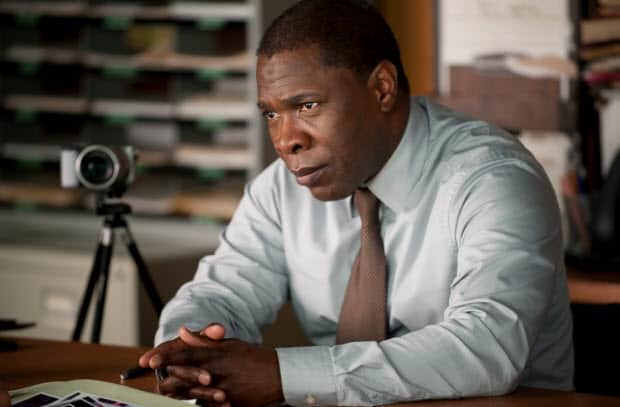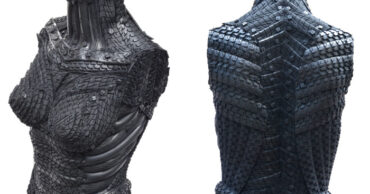
As dense as “The Secret Fate of All Life” appears to be whenever 2012 Rust Cohle opens his mouth, this week’s episode of True Detective – like the four episodes preceding it – is a rather straightforward examination of good and evil’s mirror images, the cyclical, eternal dance between hero and monster raging on every level of the universe. And although the episode takes a bit of a predictable path when the detectives in 2012 establish Cohle as a murder suspect, it encapsulates the very essence of True Detective‘s morality: the world’s a lot more gray than we think it is, and even those viewed as “heroes” by some, could just as easily be labeled “murderers” or “criminals” by another.
Cohle’s long diatribes about M-theory and the like are really quite simple: his metaphysical musings are nothing more than complicated monologues about the dualities of the universe, be it internal or external. Think of the circular nature of time as he describes it (or the wreath of limbs 2002 Cohle studies in the woods): there is no beginning or end, no given path or direction to follow. It is but a flat circle to the enlightened observer, the overlaps between birth and death, good and evil, start and finish completely invisible: everything happens once and happens again, and that repetition blends everything to the point of insignificance.
True Detective‘s been doing this quite openly with its characters, showing the good and bad within Cohle and Hart in equal light. The easiest example of this to see “The Secret Fate” is how Marty Hart’s murder of a handcuffed Reggie (calling back to Rust’s comments about the different between a ‘hunt’ and an ‘ambush’) is viewed to the public. He’s a hero in their eyes, and mostly thanks to the lies Rust concocts to keep them protected, lies he had to tell after illegally pursuing Reggie for weeks. Did Hart need to murder a man without a weapon in his hand, half-naked and handcuffed to the ground? Since when did Hart become the dealer of justice, even if the person he murdered was a child-killer? It certainly feels like justice when Marty shoots him: but the farther the episode moves away from 1995, the murkier those motivations become, just as the line between “enlightened and unhinged” and “secretly psychopathic” Rust’s disappearance for eight years becomes.
In every discernible corner of “The Secret Fate of All Lives” is this harmony between good and evil, how similar one event or action can be, when it’s compared to what we consider its polar opposite. The key is perception – and this week’s True Detective suggests that in the world, the application of “good” or “evil” is a very murky thing. Given his past, Cohle’s an unstable, borderline evil person: but compared to the hypocritical behavior of Marty, Cohle’s enlightened nature about himself gives him this appearance of nobility. It’s all BS, of course: Cohle talks his way around a point quite well, to the point that his explanations and dense literary references only further establish him as a possible suspect to the murders he’s trying to solve – a ridiculous twist, but one that works within its context, a study of how similar the sheep (the 2012 detectives, and Hart/Cohle in 1995) and the shepherds (Hart/Cohle in 2012) are underneath their vastly different surfaces.
There are times where “The Secret Fate of All Lives” seems to deliver its message a little more overt and heavy-handed than the first three episodes did, using a melodramatic plot device (could the hunter be the killer?… I suppose for Hart, they are one and the same) to help illuminate the themes of the episode. Regardless, the show’s examination of the good and bad within its two protagonists (and their various guides pointing them to Carcosa, the literal home of the Yellow King) continues to be fascinating, and where the episode stumbles (Aubrey’s a rebel, vaguely goth-ish girl doing dirty things with boys!), the mesmerizing performances of Harrelson and McConaughey more than pick up the slack when the narrative begins to strain. Life and death, good and evil, night and day: these are all two sides to the same coin, just as Cohle and Hart are to each other, an embodiment of the internal struggle between faith and reason, and the external battles between good and evil that come to define True Detective‘s nihilistic, zero-sum philosophies.
Other thoughts/observations:
– Reggie’s last words are more references to Carcosa, and the “black stars” detailed in The King in Yellow.
– Cohle calling Marty “Captain America” is a priceless moment, the rare release of tension on the show through a joke.
– after Marty shoots Reggie, Cohle talks about how to make things look “right” – as if there was any way something that went so wrong could ever .
– Rust’s new theory: the police/politicians/someone in power is part of this ritualistic killing of women, a theory gleaned from the task force’s interest in the case, the sudden mention of the Yellow King in 2002, and the incriminating comments by the 2012 detectives. Then again, it could all be in Rust’s head, the musings of a mad men unleashed by his ignorant, inattentive partner too distracted with his own failures to solve the most important case of his life.
– no, I do not think Rust is actually the killer – but after all, “the devil’s greatest trick was convincing us he didn’t exist”, no?
– Marty mentions that “inattention” was his “sin”. Blowing off the head of a handcuffed guy probably wasn’t the best choice to make morally, then.
– Rust interrogates a criminal, making him ask for forgiveness, and then denying him salvation. Again: the guy admits to committing murders, but does so through manipulative ways – and once he reveals the “truth” to Rust about Reggie, ends up dying (surely he didn’t just kill himself out of nowhere) a gruesome death, condemned to die moments after revealing his most important truth.
– what’s in Rust’s storage unit? I’m guessing 100 cartons of Camel Lights and an unhealthy amount of demon traps.
[Photo via Lacey Tyrell/HBO]
 Follow Us
Follow Us





